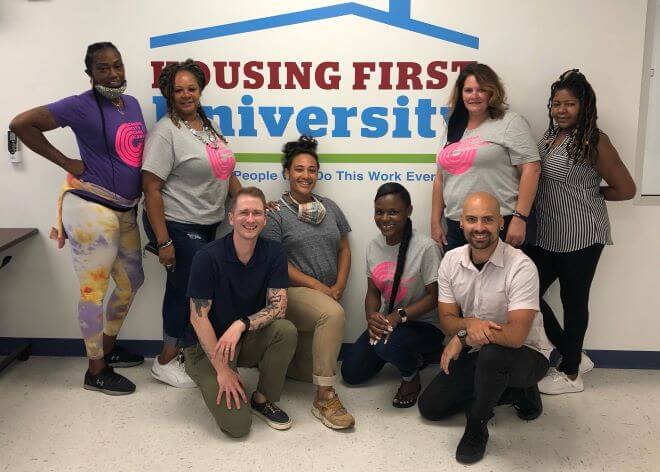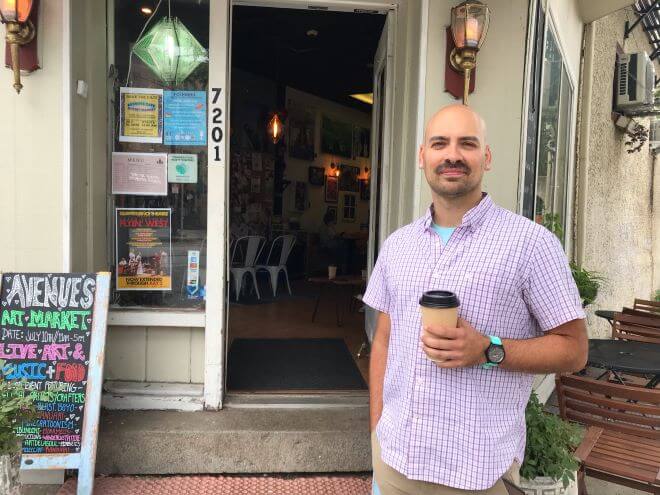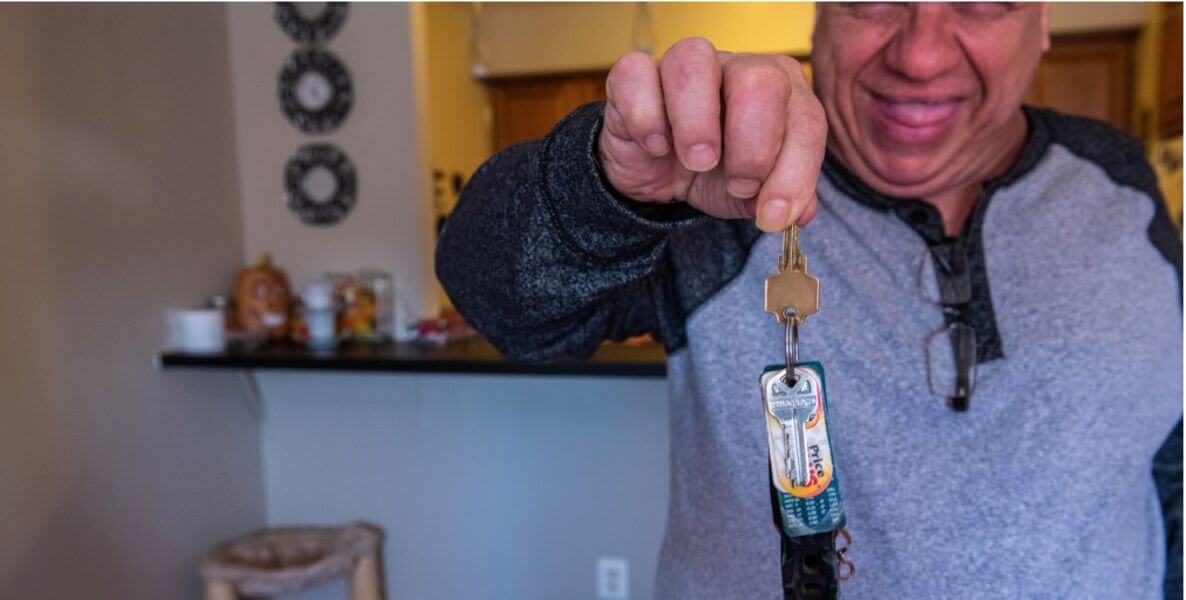If you were homeless, how easily do you think you’d be able to find or hold a job? Or tackle personal troubles — like addiction or mental-health issues — that might’ve contributed to your situation in the first place?
I’d fail fast, consumed by the anxiety of daily survival. I wouldn’t be able to do anything until I had a safe place to live. I’m not sure many people could, especially the longer their condition persisted.
That’s what makes the “Housing First” model of addressing homelessness so compelling. It’s been around since 1992 and, research shows, is more successful than other efforts to get — and keep — homeless people housed.
Locally, Pathways to Housing PA uses the Housing First model, overseeing 550 clients referred to the agency by the City. These are people for whom all other methods of addressing their chronic homelessness have failed.
Housing First puts no preconditions on those getting housed. Agencies that use the model don’t require sobriety of clients, for example, or participation in behavioral, psychiatric, or other programs, in order to qualify for permanent shelter. All a client needs to do is to decide to come in off the streets.
“The truth is, we have no idea what a homeless person has gone through, the trauma they might’ve experienced, the inequitable experiences, sometimes starting from childhood,” says Villagran.
From there, they can begin changing their lives one step at a time, with ongoing assistance from Housing First support workers who have the flexibility to help clients receive additional services — job training, medical and psychiatric care, counseling, addiction treatment — in the order that best supports their needs at the time.
This is different from the more common, and rigid, model of treating homelessness, which is to move clients through a prescribed sequence of help — moving from a shelter to transitional housing to permanent housing. Each transition must be “earned” by the client, via actions and behaviors prescribed by the agency. If a client messes up, they can be booted out.
Research shows that of those who are helped via Housing First, 85 to 90 percent remain housed after five years. (The model is also associated with reduced emergency room visits, hospitalizations, shelter use, detox services, and incarceration compared to other models.)
In contrast, only 20 to 40 percent of those helped via the sequential model retained housing after five years.
So why is Housing First still considered “radical?” Not just by some in the world of social services but in broader society, too?
It’s that lack-of-preconditions piece. It irks some people.
Hey, no one gave me a free place to live, goes one anti-Housing First sentiment. I had to earn it. So should those people.
Another gripe about the model is the belief that Housing First enables those people to continue their negative behaviors when we should be using our energy — and tax dollars — to help those who can prove they’re ready for recovery. This is a fundamental message of Michael Shellenberger’s critically acclaimed book, San Fransicko: Why Progressives Ruin Cities. Shellenberger believes Housing First detrimentally “designates some people, by identity or experience, as victims entitled to destructive behaviors.”
These viewpoints frustrate Ryan Villagran, LSW, a specialist with Housing First University, the training arm of Pathways to Housing PA. He hears them all the time.
They carry the assumption that, “with all else being equal, ‘those people’ don’t work as hard and are undeserving,” he wrote in a recent, riveting blog post for Pathways. “[Critics] both mistake our social systems for a functioning meritocracy and incorrectly assume that the only way for people to get well is to face the ‘natural consequences’ of their behavior.”
Which, he added, can be code for: suffering. As in: If you’re homeless, your life should be hard before it gets easy.
Bingo.
But what if the result of those natural consequences never moves beyond the brutal, dangerous suffering of “living rough?” Isn’t it more humane and — as research shows — more effective to reduce the harm in a clearly suffering person’s life by eliminating preconditions for those unable to meet them before being housed?
Or, as Villagran wrote, “We shouldn’t require frequent brushes with death to afford someone the stable conditions that most of us need in order to make real changes in our lives.”
Pathways’ clients, especially, need the consideration. The organization’s clients are those that, the City of Philadelphia has determined, have lived rough for years, sometimes decades.
Previous attempts to bring them inside via the sequential-services model have failed. So, in 2008, the City contracted with Pathways to give Housing First a try.
Not every effort succeeds, Villagran says; some clients cycle through multiple failed placements as they adjust to a housed life. But the organization keeps working with them to find a housing situation that fits and supports them as they move beyond basic survival to healthy stability.
The City believes in the model. In 2021, the Philadelphia’s Office of Homeless Services reported that of the 5,700 people considered as homeless, 950 were unsheltered — “the lowest number of street homeless per capita of any of the largest cities in the U.S.”
Basically, Housing First is about radical acceptance and unconditional love. I know eyes will roll at that characterization.
But is there a better way to describe compassionate interaction that’s grounded in deep listening, respect for a fellow human’s agency — no matter their current situation — and the patience to hang in there with them on the road to housing stability?
These are the tenets that enable Housing First to succeed for some clients in ways that Treatment First options do not.
Villagran’s deep respect for Pathways’ clients, staff, and mission was evident in his blog post. And he so deftly wove together seemingly unrelated observations — about things like agency, belonging and suffering, imagination and patience — that I wanted to hear more about what he does.

We met over coffee at Avenues Cafe in Mt. Airy, not far from where the warm and lively Villagran, 37, lives with his wife, who works as a therapist, and their two young children.
Ronnie Polaneczky: First off, thanks for all you do. So many people are living rough in Philly. There’s such despair out there.
Ryan Villagran: There’s tremendous need. As a trainer, I’m kind of removed from the day-to-day of it, but I’ll pass on your good wishes to the Pathways’ direct-service workers who are doing great assertive engagement on the street.
What’s assertive engagement?
In traditional service models, clients with high needs have to go to where the provider is — like to a shelter, or in-house program. Maybe they show up, maybe they don’t. With assertive engagement, providers meet people where they are — say, in a tent encampment — engage with them there, offer help, and then don’t take no for an answer. But they do it in a kind and empathetic way.
How is this different from other approaches?
With other programs, you sort of “earn” your way up through a system that’s already in place. If you screw up, you’re out. With assertive engagement, it’s more like, what do you want to work on? What do you need? We have a lot to offer but we don’t assume to know what they need.
At first, it’s mostly survival-oriented stuff, like “I need Chapstick and a beanie.” So we’ll show up the next day with Chapstick, a beanie, and coffee. And then we’ll have a conversation.
What does that sound like?
We say we can get them into housing in two to four weeks. Period. We mean it. They’ll say, “But I don’t want to go through a psych evaluation” — a common precondition to getting housing. We say, Okay, then let’s kick that can down the road for a while. They’re addicted and say, “I’m not gonna stop using.” We say, We’ll work with you on that. Basically, we want to remove the obstacles that kept them from getting housing in the past. We say, It’s your life, you’re in charge. Tell us what you need.

So they call the shots?
Yes. They have agency — we all do. If you don’t respect that, you lose trust, you lose the relationship, nothing changes. They’ve been so let down in the past, have let so many people down, they’re effectively isolated from mutually respectful encounters. Respecting their agency has to come first. From there, trust evolves. Change can happen. It takes time. We stay with them.
For how long?
However long it takes. One man had been on the street for eight years. Every frontline worker in the city — not just Pathways people — knew him. Finally, at the Pathways Christmas party [all clients are invited] he said he was ready to come inside. This was a Friday night! But no one was going to wait until Monday to start the process — you’ve got to strike while the iron is hot. Outreach workers left the party and scrambled to get a place together for him.
The day he was moved into his new apartment, he went into the bathroom and closed the door. When he didn’t come out, they checked on him. He was taking a bath. It was probably his first real bath in years. It never occurred to him to tell anyone what he was doing. Everyone was so happy for him. There were lots of tears.
“Once a person has a home, the urgency and desperation of scrambling for survival is removed, creating space for them to move incrementally toward recovery,” says Villagram. “I guess you could say recovery is a natural consequence of having our basic needs met.”
I can only imagine! Still, how do you square that with people who say eight years is too long to wait for someone to be willing to change for the better?
We need options for people who’ve tried and failed to “be better” while being homeless. We need to stop saying things like, “If only you’d been able to do this or that, the way I’ve been able to, you wouldn’t be where you are right now. If only you’d been a better person.” That’s a very American attitude, and it’s such bullshit.
The truth is, we have no idea what a homeless person has gone through, the trauma they might’ve experienced, the inequitable experiences, sometimes starting from childhood. Housing First goes against the grain of equating human failings with moral failings. It meets people where they’re at. It feels right.
What’s it like to work this way? To be able to create a plan unique to a client’s needs, not to have to bend their needs to fit a fixed program?
It’s a privilege. There’s less rigidity. We have the flexibility to be patient and creative. I work with people who deeply believe in harm reduction and relieving suffering. But it’s not easy, and the right thing to do isn’t always obvious. We still debate about how much to intervene when a client is not taking psychiatric medications and is at risk of eviction from their apartment building. But it’s still deeply satisfying work.
It sounds like satisfaction is a “natural consequence” of the work you do.
It is. We see recovery up close. Once a person has a home, the urgency and desperation of scrambling for survival is removed, creating space for them to move incrementally toward recovery. I guess you could say recovery is a natural consequence of having our basic needs met.
Ronnie Polaneczky is a veteran journalist, public speaker, certified positive psychology practitioner, and enthusiastic student of listening in all its forms. Contact her via her website, RonnieListens.com.
![]() MORE ON HOUSING INSECURITY FROM THE CITIZEN
MORE ON HOUSING INSECURITY FROM THE CITIZEN
MOST POPULAR ON THE CITIZEN RIGHT NOW



